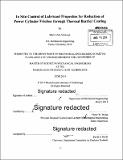In situ control of lubricant properties for reduction of power cylinder friction through thermal barrier coating
Author(s)
Molewyk, Mark Allen
DownloadFull printable version (11.48Mb)
Other Contributors
Massachusetts Institute of Technology. Department of Mechanical Engineering.
Advisor
Victor W. Wong.
Terms of use
Metadata
Show full item recordAbstract
Lowering lubricant viscosity to reduce friction generally carries a side effect of increased metal-metal contact in mixed or boundary lubrication, for example near top ring reversal along the engine cylinder liner. A strategy to reduce viscosity without increased metal-metal contact involves controlling the local viscosity away from top-ring-reversal locations. This paper discusses the implementation of insulation or thermal barrier coating (TBC) as a means of reducing local oil viscosity and power cylinder friction in internal combustion engines with minimal side effects of increased wear. TBC is selectively applied to the outside diameter of the cylinder liner to increase the local oil temperature along the liner. Due to the temperature dependence of oil viscosity, the increase in temperature from insulation results in a decrease in the local oil viscosity. The control of local viscosity through TBC targets areas of high hydrodynamic power losses mid-stroke while avoiding an increase in boundary friction near ring reversal. If temperatures near ring reversal remain unaltered, the expected result is the same oil viscosity, boundary friction, and wear rate near TDC as that of a non-insulated liner. In order to calculate the frictional benefit of insulating the cylinder liner, an in-cylinder heat transfer model predicts the temperatures along the liner. The local oil temperatures and engine performance parameters are then applied to a ring pack simulation to calculate the contributions to hydrodynamic and boundary friction power loss. The BsFC and wear rate results are then compared to baseline simulation data for TBC performance metrics. The results show the TBC insulated liner maintains adequate viscosity and film thickness near TDC for wear protection in the ring, while decreasing a significant portion of hydrodynamic for friction power loss in the mid-stroke. For the case studied, TBC offers a 0.7% BsFC improvement from the reduction in power cylinder friction with no increase in the wear rate of the ring pack.
Description
Thesis: S.M., Massachusetts Institute of Technology, Department of Mechanical Engineering, 2014. Cataloged from PDF version of thesis. Includes bibliographical references (pages 61-62).
Date issued
2014Department
Massachusetts Institute of Technology. Department of Mechanical EngineeringPublisher
Massachusetts Institute of Technology
Keywords
Mechanical Engineering.